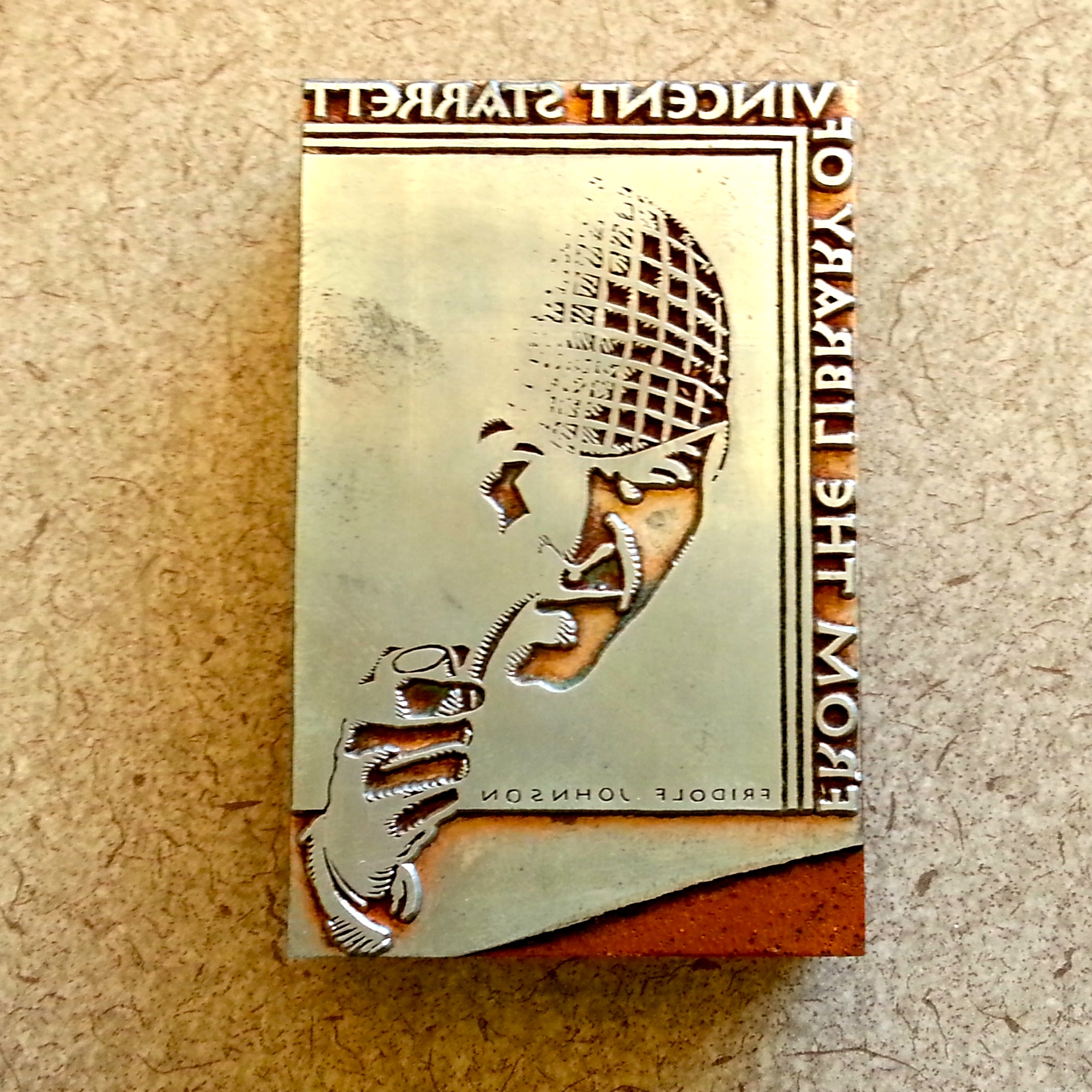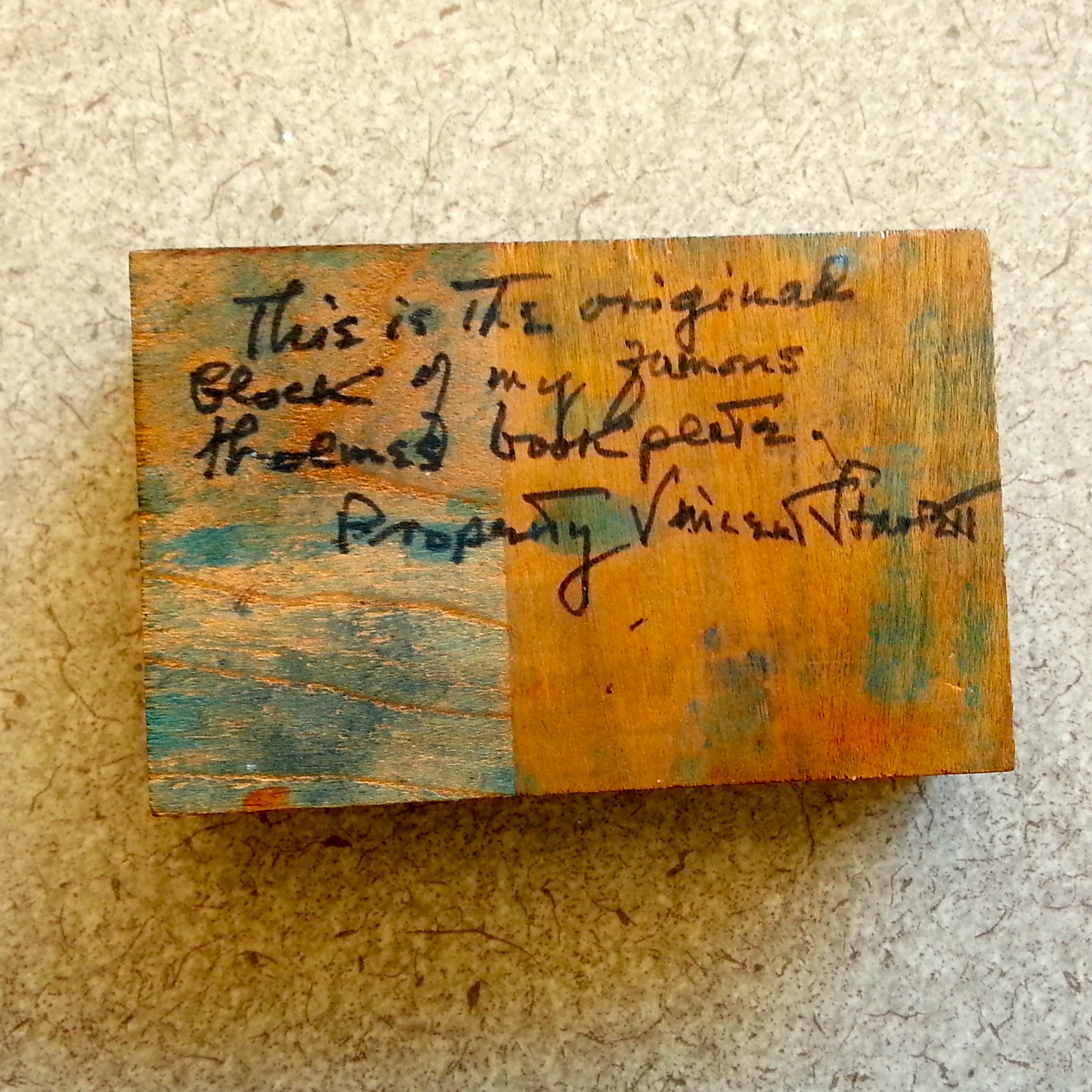The Sherlockian world's most famous bookplate, Part 2
Last time, we looked at the relationship between Vincent Starrett and Fridolf Johnson, whose iconic image of Sherlock Holmes became one of Starrett's favorite bookplates and was a key element in a 35-year friendship. This week, more on the men, the image and the mystery of Harriet.
The Original Plate
Deep in the chilly bowels of the University of Minnesota's Sherlock Holmes Collections is Box 84, with a treasure of items associated with Vincent Starrett's Sherlock Holmes bookplate. Treasure indeed: These are one-of-a-kind items by artist and bookplate expert Fridolf Johnson. I owe a tremendous debt of gratitude to fellow Sherlockian Julie McKuras, who offered to hunt out these treasures, to assistant librarian Cheryll Fong and to Timothy J. Johnson, Curator of Special Collections & Rare Books and E. W. McDiarmid Curator of the Sherlock Holmes Collections. Julie and Cheryll hunted through the collections while Tim, who is on sabbatical, guided their efforts. I am indebted to them and especially to Cheryll for the lovely images.
The original zinc block cut by Johnson from his illustration for Starrett's book plate. Photo by Cheryll Fong.
Here is the front and back of the block. As you can see, the back is inscribed by Starrett: "This is the original block of my famous Holmes bookplate. Property Vincent Starrett"


Finally, here is note from Johnson himself that describes the history of the block and the bookplate. It says:
Fridolf Johnson 34 Whitney Drive, Woodstock, New York 12498
This is the original zinc cut for Vincent Starrett's Sherlock Holmes bookplate, drawn by me early in 1931. The first printing was in black on Japan vellum. I believe I had about 150 run off. Subsequently, it was reprinted in brown on buff laid paper. Among other places, it was reproduced in the Chicago Tribune, Dec. 26, 1943; Charles Honce, A Vincent Starrett Library, Golden Eagle Press, 1941; and in Walter Klinefelter, A Packet of Sherlockian Bookplates, Private Press of the Indiana Kid, Nappanee, Indiana, 1964. The plate was damaged at some later time.
Fridolf Johnson
Johnson's note about the original zinc cut. Based on how the note is folded, it must at one time have been wrapped around the block. Photo by Cheryll Fong.
A bit of correspondence
I have on my shelves a brief letter that Starrett sent to Johnson at the height of the Great Depression. In the hopes that even this little bit of one-sided conversation between the two men might be of interest, I include it here.
The envelope for Starrett's note to Johnson. Can you make out what's in the lower left corner? I can't.
Who was where?
The envelope is postmarked 11 p.m. Nov. 15, 1931. It was a Sunday.
Fridolf Johnson's address was 75 East Wacker Drive, which is at the south end of Chicago's famous Michigan Avenue Miracle Mile. There is a Club Quarters hotel on the site today.
Starrett was living in the Buena Oaks Hotel, at 940 Buena Park Terrace, about five miles north of downtown Chicago. The area has grown to be popular once again, with a good selection of jazz clubs, restaurants and a few little theaters. Karen Murdock, in her exhaustive work, Sherlock Alive, notes on page 456 that in 1928 Starrett "lives in Buena Oaks Hotel ( "A Bachelor Hotel" ) … from 1928 to 1932."
Can anyone make out the words in the bottom left of the envelope? I can't. (NOTE: See the comments for an explanation.)
The note
The note is transcribed as follows.
(The only word that puzzles me is in the salutation. It's not Dear Fridolf or Dear Johnson. It looks like Dear Lester or Dear Fester, but that can't be right. Any other guesses?) (NOTE: Again, see the comments.)
Can anyone make out the name in the salutation? Again, I'm baffled.
Saturday nite
Dear Lester –
Thanks greatly, old
man! I'm happy to
have the magazine —
and it was good of
you to leave them
for me. I hope all
things go well for you
in these troublous times.Give me a 'ring' some
time and perhaps we
can have a talk.Sincerely,
V.S.
The mention of "troublous times" reminds us the letter was written as the Great Depression was slowly ruining the lives of many in this nation. Starrett clearly wants to keep this an upbeat note, and ends with my favorite use of his initials, in what I call the "Starrett smiley."
The image lives on
The title page from the 1950 edition of The Baker Street Quartette, edited by Edgar W. Smith
The original image of Sherlock Holmes that Fridolf Johnson drew for Starrett ended up in numerous other places over the decades. I could cite many examples, but we can let just a few represent the whole.
Edgar W. Smith used the image in several publications, including the title page to A Baker Street Quartette. The popular booklet was published by The Baker Street Irregulars Inc. in 1950.
That means the image was still being reproduced, some 20 years after it was first used as Vincent Starrett's bookplate.
As you can see from the accompanying illustration, over the decades the image lost its identification with Starrett and the name of its creator, as it became a more generalized representation of the master detective.
The cover from Susan Rice's valuable book.
And on, and on . . . .
For those attuned to the Golden Age of Sherlockian activity, Johnson's image of Sherlock Holmes holds a high value.
There are few Starrettians whom I respect and admire more than Susan Rice. Her little book on Starrett , The Somnambulist and the Detective, is a work every Starrett and/or Sherlock Holmes aficionado should own.
Susan reports: "All the illustrations in the book were from my bits and pieces -- I gathered all of them into a parcel, included a copy of The Last Bookman, and sent everything to my editor (John Addy) in England. He chose and placed everything, except the cover. I chose that."
And she chose well indeed.
Laura Page and Robert Mangler at the Oct. 26, 1986 dedication of the Vincent Starrett headstone. Photo by Tom Cruze for the Chicago Sun-Times.
And on forever
Starrett died in 1974 and his grave was unmarked for many years except for a small nameplate at the Graceland Cemetery.
To mark the 100th anniversary of Starrett's birth, a group of his admirers got together to raise funds for an appropriate headstone, which was put in place in 1986.
The tale of this noble effort will be discussed at a later date. For now, let it be sufficient to observe that Johnson's image was etched into the book-like sculpture which decorates the stone.
The relationship between Starrett and Johnson is thus made permanent for as long as the stone remains undisturbed.
A note about the photo: The image is the original from the Chicago Sun-Times files. In the days before digital photography, details on a news photo would be "burned" to ensure their reproduction in the paper. That's why there are smudges on the words and images in the top of the headstone.
Johnson's own bookplate
One of Fridolf Johnson's bookplates.
Fridolf Johnson's papers are archived at the University of Delaware. The university's site includes biographical information on Johnson, who studied at "the Art Institute of Chicago and then remained in Illinois for nine years as art director for the Frankel-Rose Agency."
Clearly, it was during this period where Johnson and Starrett came within each other's orbit.
During his life, Johnson created several bookplates for himself. Here is one.
Johnson was passionate about bookplates and type. One of his best-known contributions to the literature was Treasury of Bookplates from the Renaissance to the Present. Johnson did not include either of the two he created for Starrett.
Harriet? Who's Harriet?
And what's up with this verse?
Who was Harriet?
Here's the little bit of Starrett's verse that was tipped into Fridolf Johnson's copy of Banners in the Dawn.
I have to admit that is is one of the more puzzling bits of Starrett's poetry that I've read. Who was Harriet? Why did she have to be removed? Why were doctors needed?
The whole poem has the feeling of the leftover bits and memory that remain after a long night's carouse. And that's where we will end this exploration into the works of Vincent Starrett.
